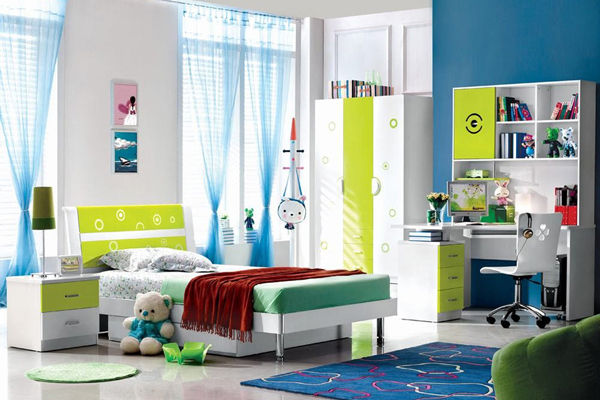
Room for kids
Consider several variables before arranging a room for kids. Available floor space, in addition to the number and ages of children sharing a room has a significant impact on a room arrangement. Also, determine the desired activities you’d like the bedroom to accommodate when creating your floor plan. Designing a room arrangement on paper before you begin to randomly move furniture pieces can save you time and effort.
Sketch
Stretch a tape measure to measure the length and width of the bedroom to determine available floor space. Sketch the corresponding measurements onto a sheet of graph paper, using one graph block to equal 12 inches. Measure the windows, doors and built-ins, and include those in your sketch. Also, note on the sketch the approximate location of electrical outlets and wall switches. Measure any furniture pieces you’d like to use, and sketch each piece to scale on a separate piece of graph paper. Cut out the furniture pieces to help you create your room arrangement.
Zones
Dividing the room into zones will give you an idea of available floor space for desired activities. Create four equal zones on your bedroom sketch. Position the cutout of your child’s bed in one zone. A bed is typically placed facing the door against a wall. You may need two zones for sleeping when two or more children are sharing the same room. Designate a desired activity — such as studying, lounging, watching television, using the computer, playing board games or drawing — for each of the remaining zones. Position paper furniture pieces in each zone that are needed for each selected activity. For example, a study zone typically requires a student desk, chair and bookshelf.
Organized Storage
A kid’s room can become cluttered, unorganized and dysfunctional without organized storage. Closet organizers are ideal for providing neat and orderly storage areas. Racks, shelves, drawers, cabinet units, hooks and baskets can be combined to supply a custom-designed closet organizer for your child’s room. Built-in bookshelves and cabinets provide permanent storage space in a room. Toy chests, open cubicles, wall shelves, storage benches, armoires, dressers and chests of drawers are stand-alone storage solutions. Plastic tubs designed to fit under a bed or under-the-bed drawers provide additional storage space.
Other Ideas
In smaller bedrooms shared by two or more children, consider bunk beds, as well as furniture pieces that serve more than one function, to save valuable floor space. For instance, a small table and chairs is ideal for playing games, hosting a tea party, putting together a model, or coloring a picture. Some bunk beds even come with attached desks, chests of drawers and storage steps built into a single space-saving unit. Place a low set of open shelves between two twin beds to divide a room for kids, giving each child his own personal space. A themed area rug — such as a race track, farm, alphabet, outer space, zoo or jungle — creates a cozy place to play.
When designing a room for kids, there are several factors to consider to create a functional and enjoyable space. Here are some key considerations:
1. Safety: Ensure that the room is childproofed with measures such as outlet covers, secure furniture, and non-toxic materials.
2. Space utilization: Optimize the use of space by incorporating storage solutions like shelves, bins, and toy organizers to keep the room tidy and organized.
3. Age-appropriate design: Consider the age and interests of the child when selecting furniture, colors, and decor. Younger children may benefit from soft, rounded edges and bright, stimulating colors, while older children may prefer more neutral tones and furniture that can adapt as they grow.
4. Play and learning areas: Dedicate areas for play, creativity, and learning. This can include a designated play corner, a desk or table for crafts and homework, and comfortable seating for reading or relaxation.
5. Flexibility: Design the room with flexibility in mind to accommodate changing needs and interests as the child grows. Consider furniture that can be easily adjusted or repurposed.
6. Personalization: Allow the child to have input in the design process and incorporate elements that reflect their personality and interests, such as themed decor or artwork.
7. Lighting: Ensure adequate lighting for various activities, including natural light during the day and adjustable artificial lighting for different moods and tasks.
Remember, safety, functionality, and creating a nurturing environment should be the primary focus when designing a room for kids.
Read more: 51 Modern Kids Room Idea




